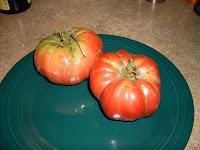


The first Brandywines of the season were ready this morning--well, perhaps they were ready a few days ago. I couldn't resist an early morning taste, so I dug into the largest tomato, which was, unsurprisingly, the first to appear on the vine a couple months ago.
Here's a quick summary of the "tasting":
Appearance: Some pulls in the skin and a few over-ripened areas. The former are likely the result of sporadic watering early on and then the deluge of rain the last few weeks--another lesson learned for late-season tomato tending.
Smell: Beautiful, zesty earthiness of a fresh tomato. Sweetness apparent.
Taste: Wonderfully sweet, with a balanced earthiness and a bit of smokiness. These two tastes taken together may be what others describe as the "wine-like" quality of the aptly named Brandywine, but I'll need a few more to confirm this conclusion.
Mouthfeel: While a few pieces were over-ripened by a great deal, the texture of the fruit is perfect. Firm enough to hold together when cut, yet delicate and soft.
Eat-ability: While these first two pickin's aren't blue ribbon quality in appearance, the taste is divine. I definitely see a tomato sandwich in my future this afternoon.
Bon appetit!
-Chauncey














































